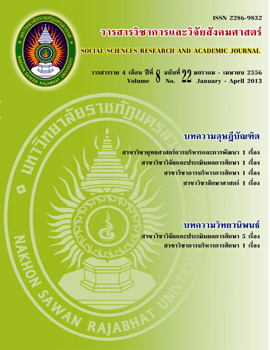การพัฒนารูปแบบการประกันคุณภาพภายในสถานศึกษา โดยใช้การประเมินแบบเสริมพลังสำหรับวิทยาลัยเกษตรและเทคโนโลยี
Main Article Content
Abstract
บทคัดย่อ
การวิจัยครั้งนี้มีวัตถุประสงค์ดังนี้ 1) เพื่อพัฒนารูปแบบการประกันคุณภาพภายในสถานศึกษา โดยใช้การประเมินแบบเสริมพลัง สำหรับวิทยาลัยเกษตรและเทคโนโลยี และ 2) เพื่อประเมินผลการใช้รูปแบบการประกันคุณภาพภายในสถานศึกษาโดยใช้การประเมินแบบเสริมพลัง สำหรับวิทยาลัยเกษตรและเทคโนโลยี วิธีดำเนินการวิจัยแบ่งเป็น 2 ระยะ คือระยะที่ 1 การพัฒนารูปแบบการประกันคุณภาพภายในสถานศึกษาโดยใช้การประเมินแบบเสริมพลัง สำหรับวิทยาลัยเกษตรและเทคโนโลยี กลุ่มตัวอย่างประกอบด้วย ผู้บริหาร หัวหน้าแผนกวิชา ครูผู้สอน หัวหน้างานและเจ้าหน้าที่ประกันคุณภาพการศึกษา รวมจำนวน 264 คน ผู้เชี่ยวชาญ จำนวน 5 คน เครื่องมือที่ใช้ในการวิจัย ได้แก่ แบบสอบถาม วิเคราะห์ข้อมูลโดยหาค่าดัชนีความสอดคล้อง ค่าเฉลี่ย ส่วนเบี่ยงเบนมาตรฐาน และการวิเคราะห์เนื้อหา และระยะที่ 2 การประเมินผลการใช้รูปแบบการประกันคุณภาพภายในสถานศึกษาโดยใช้การประเมินแบบเสริมพลัง สำหรับวิทยาลัยเกษตรและเทคโนโลยี ดำเนินการโดยนำรูปแบบการประกันคุณภาพไปใช้กับวิทยาลัยเกษตรและเทคโนโลยีตรัง ผู้ให้ข้อมูลคือผู้บริหารและครู จำนวน 59 คน เครื่องมือที่ใช้ในการวิจัยได้แก่แบบสอบถาม สถิติที่ใช้ในการวิเคราะห์ข้อมูล ได้แก่ ค่าเฉลี่ย ส่วนเบี่ยงเบนมาตรฐาน และการวิเคราะห์เนื้อหา
ผลการวิจัยพบว่า
1. รูปแบบการประกันคุณภาพภายในสถานศึกษาโดยใช้การประเมินแบบเสริมพลังสำหรับวิทยาลัยกษตรและเทคโนโลยี ประกอบด้วย 2 มิติ คือมิติการประกันคุณภาพภายในสถานศึกษา กับมิติการประเมินแบบเสริมพลัง มียุทธวิธีดำเนินการ คือ 1) การฝึกอบรม 2) การให้คำปรึกษา 3) การอำนวยความสะดวก 4) การสร้างความกระจ่างและ 5) การให้เสรีภาพในการปฏิบัติ
2. ผลการประเมินการใช้รูปแบบการประกันคุณภาพภายในสถานศึกษาโดยใช้การประเมินแบบเสริมพลัง สำหรับวิทยาลัยเกษตรและเทคโนโลยี โดยรวมมีคุณภาพระดับมาก ทั้งด้านความเป็นประโยชน์ ความเป็นไปได้ ความเหมาะสม และความถูกต้อง ผู้บริหารและครูมีความรู้ความเข้าใจเพิ่มขึ้นและมีความพึงพอใจต่อการประกันคุณภาพภายในสถานศึกษาในระดับมาก
Abstract
The objectives of the research were to develop and evaluate an Internal Quality Assurance Model Using Empowerment Evaluation for Agriculture andTechnologyColleges. This research consisted of two phases. The samples in phase 1 consisted of 264 administrators, teachers, head of division and participants and 5 specialists in evaluation and quality assurance. In phase 2 there were 5 administrators and 54 teachers ofTrang Agriculture andTechnologyCollege. Data collection used questionnaires and document analysis. Data analysis used descriptive statistics which were frequency distribution, percentage, mean and standard deviation. Inferential statistics for testing statistical significance was t-test. Qualitative data analyzing method used in this study was content analysis.
Research findings were as follows:
1.An Internal Quality Assurance Model Using Empowerment Evaluation for Agriculture and TechnologyColleges consisted of 2 main dimensions: 1. The process of an internal quality assurance can be defined into seven steps as: defining educational standards, strategy planning, planning implementation, audit quality, internal evaluation, annual self-study report writing, assessed improvement successively, and 2. Steps of framework empowerment evaluation can be defined into four steps as: 1) Taking stock. 2) Setting goals. 3) Developing strategies. 4) Documenting progress. The strategy were divided in tasks: training, coaching and facilitating, advocacy, illumination and liberation.
2. The results of evaluation of the Internal Quality Assurance Model Using Empowerment Evaluation for Agriculture andTechnologyCollegesafter a pilot test showed that the model was of high level in terms of utility, feasibility, property and accuracy. The administrators and teachers have increased knowledge and they were satisfied with internal quality assurance at the high level.


